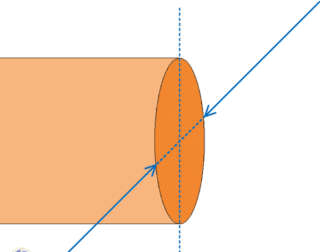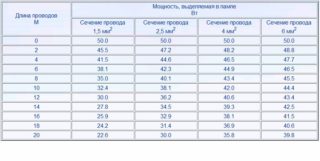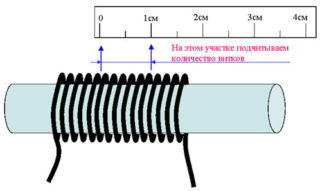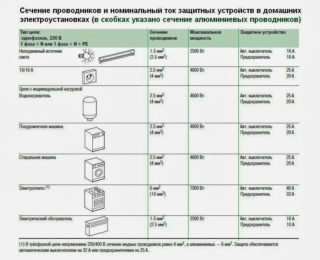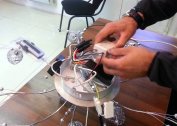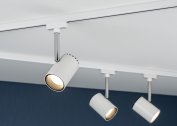For the correct selection and organization of the power line, it is necessary to take into account the parameters and load of the conductors. They are a metal thread made of copper, aluminum, steel, zinc, titanium, nickel and provide the transfer of current from its source to the consumer. Conductors have a cross section - this is a figure formed from their dissection by a plane of the transverse direction. If you pick it up incorrectly, the line will fail or light up during power surges.
Cross-sectional area as an electrical quantity
As an example of a cross-section, we can consider cutting the product at an angle of 90 degrees relative to the transverse axis. The outline of the resulting figure is determined by the configuration of the object. The cable has the appearance of a small pipe, so when sawing a figure comes out in the form of two circles of a certain thickness. With a cross section of a round metal rod, a circle shape is obtained.
In electrical engineering, the area of the PS will mean a rectangular section of the conductor in relation to its longitudinal part. The section of veins will always be round. Parameter measurement is carried out in mm2.
Novice electricians can mix up the diameter and cross-section of the elements. To determine what sectional area the vein needs, you need to take into account its round shape and use the formula:
S = πxR2, where:
- S is the area of the circle;
- π is a constant value of 3.14;
- R is the radius of the circle.
If the area index is known, it is easy to find the resistivity of the fabrication material and the length of the wire. Next, the current resistance is calculated.
For the convenience of calculations, the initial formula is transformed:
- Radius is ½ diameter.
- To calculate the area, π is multiplied by D (diameter) divided by 4, or 0.8 is multiplied by 2 diameters.
In calculations, a diameter indicator is used, since its incorrect selection can cause overheating and ignition of the cable.
Calculation Goals
It is necessary to calculate the parameters of the cross-sectional area of the conductor for several purposes:
- obtaining the necessary amount of electricity to power household appliances;
- the exception of overpayments for unused energy;
- safety wiring and the prevention of fires;
- the ability to connect high-power equipment to the network;
- prevention of melting of the insulating layer and short circuits;
- proper organization of the lighting system.
The optimum wire cross section for lighting is 1.5 mm2 for the line, 4-6 mm2 at the input.
The ratio of the diameter of the cable with its cross-sectional area
Determining the cross-sectional area of the conductors by a formula takes a long time. In some cases, it is appropriate to use data from a table. Since a copper cable is used to organize modern wiring, the following parameters are entered in the table:
- diameter;
- section in accordance with the indicator of diameter;
- ultimate load power of conductors in networks with voltage of 220 and 380 V.
| Core diameter, mm | Section parameters, mm2 | Current strength, A | Power of a copper conductor, kW | |
| 220 V network | 380 V network | |||
| 1,12 | 1 | 14 | 3 | 5,3 |
| 1,38 | 1,5 | 15 | 3,3 | 5,7 |
| 1,59 | 2 | 19 | 4,1 | 7,2 |
| 1,78 | 2,5 | 21 | 4,6 | 7,9 |
| 2,26 | 4 | 27 | 5,9 | 10 |
| 2,76 | 6 | 34 | 7,7 | 12 |
| 3,57 | 10 | 50 | 11 | 19 |
Having looked at the data in the corresponding columns, you can find out the necessary parameters for the power line of a residential building or production facility.
The calculation of the cross section of a stranded conductor
 Stranded wire is a few separate cores. The calculation of its cross section is as follows:
Stranded wire is a few separate cores. The calculation of its cross section is as follows:
- An indicator of the cross-sectional area of one core is found.
- Cable conductors are recounted.
- The number is multiplied by the cross section of one core.
When connecting a stranded conductor, its ends are crimped with a special sleeve using crimping pliers.
Features of self-calculation
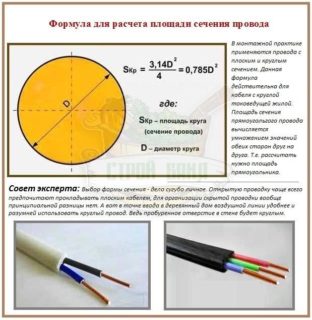 Self-calculation of the longitudinal section is performed on a core without insulation coating. A piece of insulation can be pushed or removed on a piece purchased specifically for testing. First you need to determine the diameter and find the cross section from it. For work, several techniques are used.
Self-calculation of the longitudinal section is performed on a core without insulation coating. A piece of insulation can be pushed or removed on a piece purchased specifically for testing. First you need to determine the diameter and find the cross section from it. For work, several techniques are used.
Using a caliper
The method is justified if the parameters of a truncated or defective cable are measured. For example, VVG can be designated as 3x2.5, but actually be 3x21. The calculations are made as follows:
- The insulation coating is removed from the conductor.
- Diameter is measured with a caliper. You will need to position the wire between the legs of the instrument and look at the scale notation. The integer is at the top, the decimal is at the bottom.
- Based on the formula for finding the circle area S = π (D / 2) 2 or its simplified version S = 0.8 D², a cross section is determined.
- The diameter is 1.78 mm. Substituting the value into the expression and rounding the result to hundredths, we get 2.79 mm2.
For domestic purposes, conductors with a cross section of 0.75 will be needed; 1.5; 2.5 and 4 mm2.
Using ruler and pencil
In the absence of a special meter, you can use a pencil and a ruler. Operations are performed with a test image:
- The area equal to 5-10 cm is cleaned from the insulating layer.
- The resulting wire is wound on a pencil. Full turns fit tightly, there should be no space between them, “tails” are sent up or down.
- In the end, a certain number of turns should be obtained, they need to be counted.
- The winding is applied to the ruler so that the zero division coincides with the first winding.
- The length of the segment is measured and divided by the number of turns. The resulting value is the diameter.
- For example, it turned out 11 turns, which occupy 7.5 mm. When dividing 7.5 by 11, 0.68 mm comes out - the diameter of the cable. The cross section can be found by the formula.
The accuracy of the calculations is determined by the density and length of the winding.
Table of correspondence of the diameter of the wires and their cross-sectional area
If it is not possible to pass diameter testing or make a calculation at the time of purchase, it is allowed to use the table. Data can be photographed, printed, or rewritten and then applied to find a regulatory or popular core size.
| Cable diameter mm | Conductor cross section, mm2 |
| 0,8 | 0,5 |
| 0,98 | 0,75 |
| 1,13 | 1 |
| 1,38 | 1,5 |
| 1,6 | 2 |
| 1,78 | 2,5 |
| 2,26 | 4 |
| 2,76 | 6 |
| 3,57 | 10 |
When buying an electric cable, you will need to look at the parameters on the label. For example, VVNG 2x4 is used. Number of cores - value after "x". That is, the product consists of two elements with a cross section of 4 mm2. Based on the table, you can check the accuracy of the information.
Most often, the cable diameter is smaller than stated on the package. The user has two options - use another or choose a cable with a larger cross-sectional area in diameter. Choosing the second, you need to check the insulation. If it is not solid, thin, different in thickness, stop at the products of another manufacturer.
Determination of the cross section of the conductor at the input
 You can clarify the nominal indicators in the company Energosbyt or documentation for the goods. For example, the rating of the machine at the input is 25 A, the power consumption is 5 kW, the network is single-phase, at 220 V.
You can clarify the nominal indicators in the company Energosbyt or documentation for the goods. For example, the rating of the machine at the input is 25 A, the power consumption is 5 kW, the network is single-phase, at 220 V.
The cross-section is selected so that the permissible current of conductors for a long period is greater than the nominal value of the machine. For example, a three-core copper conductor VVGng, laid in an open way, was put into the house at the entrance. The optimum cross section is 4 mm2, so VVGng 3x4 material will be needed.
After that, the indicator of the conditional shutdown current for a machine with a nominal value of 25 A is calculated: 1.45x25 = 36.25 A. For a cable with a cross-sectional area of 4 mm2, the parameters of the long-term allowable current are 35 A, conditional - 36.25 A. In this case, it is better to take the input copper conductor with a cross section of 6 mm2 and a permissible current limit of 42 A.
Calculation of the wire section for the line of sockets
Each appliance has its own power indicators. They are measured in watts and indicated in the passport or on a sticker on the case. An example of a cross section search would be the washing line for a 2.4 kW washing machine. When calculating the following:
- wire material and installation method - three-core VVGng-cable made of copper, hidden in the wall;
- sectional features - the optimal value is 1.5 mm2, i.e. need a 3x1.5 cable;
- use of an outlet. If only an automatic machine is connected, the characteristics will be sufficient;
- protection system - automatic, rated current of 10 A.
For double sockets, a copper cable with a cross section of 2.5 mm2 and an automatic machine with a nominal value of 16 A. is used.
Cross-sectional selection for a three-phase 380 V line with several devices
Connecting several types of household appliances to a three-phase line provides for the flow of consumed current through three cores. In each of them there will be a smaller value than in a two-core. Based on this phenomenon, a cable with a smaller cross section is allowed to be used in a three-phase network.
For example, a generator with a power of 20 kW and a total power of three phases of 52 A is installed in the house. Based on the values of the table, it turns out that the optimal cable section is 8.4 mm2. Based on the formula, the actual cross section is calculated: 8.4 / 1.75 = 4.8 mm2. To connect a 20 kW generator to a three-phase 380 V network, a copper conductor is required, the cross section of each core of which is 4.8 mm2.
Wire cross section in old buildings and ultimate load
In high-rise buildings of the Soviet period, aluminum wiring is used. Given the correct connection of nodes in the distribution box, insulation quality and reliability of the connection contacts, it will last from 10 to 30 years.
If it is necessary to connect equipment with high energy intensity in houses with aluminum wiring, the cross-section and the diameter of the cores are selected based on the power consumption. All data are shown in the table.
| Current, A | Maximum power, VA | Cable diameter mm | Cable section, mm2 |
| 14 | 3000 | 1,6 | 2 |
| 16 | 3500 | 1,8 | 2,5 |
| 18 | 4000 | 2 | 3 |
| 21 | 4600 | 2,3 | 4 |
| 24 | 5300 | 2,5 | 5 |
| 26 | 5700 | 2,7 | 6 |
| 31 | 6800 | 3,2 | 8 |
| 38 | 8400 | 3,6 | 10 |
Which cable to choose for apartment wiring
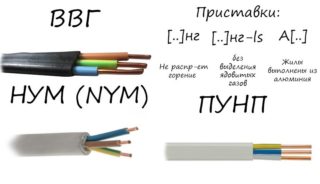 Despite the low cost of aluminum conductors, it is better to abandon their use. The reason is the low reliability of the contacts through which currents will pass. The second reason is the mismatch of the power wire cross section of modern household appliances. The copper cable is reliable and has a long service life.
Despite the low cost of aluminum conductors, it is better to abandon their use. The reason is the low reliability of the contacts through which currents will pass. The second reason is the mismatch of the power wire cross section of modern household appliances. The copper cable is reliable and has a long service life.
In apartments and houses it is allowed to use a wire with the marking:
- PUNP - a flat conductor with copper conductors in a PVC shell. Designed for a voltage of 250 V at a frequency of 50 Hz.
- VVG / VVGNG - flat copper cables with double PVC coating. They are used inside and outside buildings, are not subject to fire. There are with 2, 3 and 4 veins.
- NYM is a copper wire for an internal single line. It has an insulating PVC sheath and an outer coating, conductors with and without grounding.
When choosing the number of cores, it will be necessary to take into account the ability of conductivity per unit section. In this case, the apartment network is best made from a single-core wire, the thickness of which is greater. Stranded elements can be bent repeatedly, to connect electrical appliances to them. Only a cable with thin wires will be of high quality.
The correct cross-section of the conductors, taking into account the power of the equipment and the type of network are important factors in organizing the power line. The diameter of the cable can be calculated independently in several ways. Based on these indications, it is easy to determine the cross section of the cores by formulas or using a table.
